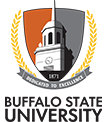Alternate Format Materials - Faculty FAQ's
The majority of the students with this accommodation at Buffalo State University require the provision of accessible (readable) electronic files, which students access using software or apps on their computers, tablets and phones.
Alternate Format refers to the conversion of academic materials to accessible formats for students with a variety of disabilities.
Formats may include digital text, large print, Braille and tactile graphics.
Yes, faculty are responsible for ensuring their course materials on Brightspace (or any other online platform) are accessible with screen readers. Please visit the IT Knowledge Base and enter the keyword 'Accessibility' for information on how to check your materials for accessibility.
List all your course textbooks in the Barnes and Noble at Buffalo State Bookstore so that students can request their Alternate Format Materials from Student Accessibility Services ASAP.
Avoid adding new physical materials during the semester. If you need to add new materials to your course throughout the semester, ensure that you give them to students with enough time for the student to work with Student Accessibility Services to have them adapted into an accessible format.
Students who take their exams in the Testing Center at Student Accessibility Services and use Alternate Format Materials will require their exams to be sent to the Testing Center in electronic format through Accommodate. The Testing Center will ensure that the student receives the Alternate Format that they require based on their accommodations.
Remember that students may choose not to use some or all of their approved accommodations in your course, or may choose to use accommodations sporadically. If a student is electing to take their exam in the classroom, faculty should ensure what accommodations, if any, the student is expecting to use on the exam. If faculty need assistance at anytime regarding how to apply accommodations in the classroom, please reach out to the staff at Student Accessibility Services.
There sure is! The Instructional Design team on campus has a plethora of resources for creating accessible content and incorporating universal design for learning (UDL) in the classroom.

